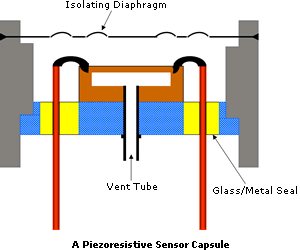Strain Gauge Pressure Sensors
Strain gauge or foil gauge technology makes use of the changes in resistance that some materials experience due to change in its stretch or strain. Here, the technology uses the change of conductivity of material when it experiences different pressures and calculates that difference, then maps it to the change of pressure.
A strain gauge is a long length of conductor arranged in a zigzag pattern on a membrane. When it is stretched, its resistance increases. Strain gauges are mounted in the same direction as the strain and often in fours to form a full ‘Wheatstone Bridge’. A pressure sensor can contain several similar strain gauge elements.

Fibre Optic Pressure Sensors
This technology uses the properties of fibre optics to affect the light propagating in a fibre, such that it can be used to form sensors. Pressure sensors can be made by using miniature fibre optic interferometers to sense nanometer-scale displacement of membranes. Pressure can also be made to induce loss into a fibre to form intensity-based sensors.
Mechanical Deflection
This technology uses the mechanical properties of a liquid to measure its pressure. For example, the effect of pressure on a spring system and the changes of compression of a spring can be used to measure pressure.
Semiconductor Piezoresistive
To measure pressure, this technology uses the change in conductivity of semiconductors due to the change in pressure.
Microelectromechanical Systems (MEMS)
Here, the technology combines microelectronics with miniature mechanical systems such as valves and gears, all on a single semiconductor chip using nanotechnology to measure pressure.
Vibrating Elements (e.g. silicon resonance)
To calculate the pressure, vibrating elements are used to gauge the change in vibration on a molecular level of the different material elements due to changes in pressure.
Variable Capacitance
This technology uses the change of capacitance due to change of the distance between the plates of a capacitor because of change in pressure to calculate the pressure.
Pressure Sensor Applications
Pressure Sensing
Pressure sensors are used in a wide variety of applications. When used directly to measure pressure, applications include weather instrumentation, aerospace and defence, research and development, automotive and many other machinery or equipment that has pressure functionality implemented.
Potential uses of pressure sensors are hydraulic systems, water depth, pneumatics, marine, sewage, gas, medical, food and beverage processing, tank level/contents, HVAC systems, agricultural equipment, aerospace and chemicals.
Other special versions of pressure sensors are common, including high temperature pressure sensors, three-in-one pressure sensors, ATEX-certified pressure transducers, hygienic pressure sensors and field-adjustable pressure sensors. Ceramic pressure sensor capsules, low cost foil strain gauge type pressure sensors, depth/level transmitters, differential pressure transmitter (wet/wet type and dry air/gas type) are other popular variations.
Flow Sensing
Here, pressure sensors utilise the Venturi Effect in order to measure the flow. Differential pressure is measured between two segments of a Venturi tube that have a different aperture. The pressure difference between the two segments is directly proportional to the flow rate through the Venturi tube. A low pressure sensor is almost always required as the pressure difference is relatively small.
Altitude Sensing
This is useful in commercial and military aircraft, rockets, satellites and weather instrumentation. These types of application all make use of the relationship between changes in pressure relative to the altitude.